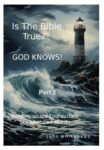Chapter 8
Jesus’ Resurrection
But the good news is that Jesus’ death was not the end. God raised him to a new life. The same yet different. The same because only a few days after his death he showed his disciples the scars. He ate and drank with them. These scars no longer spoke of the despair of suffering and crucifixion but of the glory of a resurrection and new life. Different because this new life, unlike Lazarus, was not restricted to space and time. We read for instance that the disciples were in a locked room and Jesus came and stood among them. It is a life which he will continue living forever. His wounds were transformed from a testimony of what the enemy had sought to inflict, to become a witness to all that God had overcome.
This is what the Bible says happened next, as described in John’s Gospel.
Early in the morning, two days later on the Sunday, Mary Magdalene went to the tomb to anoint Jesus’ body. When she got there she saw the stone had been rolled away and looking inside saw that the tomb was empty. She ran back and told the disciples that the body had gone. Peter and John ran back with her to see what had happened. Sure enough they found the tomb empty and that the grave clothes had been folded neatly. They still did not understand the scripture that said Jesus would rise from the dead. Not really surprising as it was something that had never happened before or since. Then they went back to their homes but Mary stood at the entrance of the tomb weeping. As she wept she bent over to look into the tomb and saw two angels in white seated where Jesus’ body had been, one at the head and the other at the foot. At this she turned round and saw Jesus standing there, but she did not recognise him until he spoke her name in his immediately recognised voice.
Here was Mary, a mere woman, in a man’s world where women had a low place on the social spectrum and could not even be relied on in court as credible witnesses. Mary numbered among the first of his disciples. She was not chosen by Jesus as an apostle, but now she is charged with the duties of an apostle, sent to the eleven apostles who were in hiding, to tell them that Jesus was alive, risen from the dead. Here is another example of the important role and the elevated position that Jesus gave and still gives to women.
This was a pivotal moment never to be exceeded, in that moment changing the whole course of human history. The reality was that the whole world had changed forever as a result of the events of that first Easter weekend.
The risen Jesus continued to appear in bodily form for 40 days after his resurrection before he was “taken up” into heaven to be with God the Father. He did not leave us completely, but later sent his Spirit to be with us forever.
The Bottom Line
The Crucifixion and Resurrection of Jesus was such a world-changing event that volumes have been written and continue to be written, looking into the impact on the whole of creation of this one event. So what is actually going on?
● Death was defeated
● Satan and the powers of evil were conquered
● Jesus died in our place. He took the punishment we deserve.
● He inaugurated a New Kingdom. The Kingdom of God was brought into being, giving each one of us the opportunity to become citizens.
All this is tied up in that one biblical jargon word, Atonement, at-one-ment. Through Jesus’ sacrifice we become “at one” with God.
It is the turning point of the whole of human history, from Adam and Eve, through the story of Noah, then Abraham, Moses, slavery and freedom, the Kingdom of Israel with its successes and failures, the predictions and prophecies, human failures- sin and means of forgiveness.
The message of the whole of the Bible can be summed up in three very simple statements, which are the conclusions of the authenticated observations of the previous chapters.
● All have sinned. (Romans 3:23)
● Christ died for us. He died the death we deserve. (Romans 5:8)
● The wages of sin is death, but the gift of God is eternal life through Christ Jesus. Confess with your mouth that Jesus is Lord and you shall be saved. (Romans 10:9).
The Kingdom of God
Entering this kingdom offers a new way of life. It is something we could never attain on our own but it is offered to us as a gift. It requires faith, recognising our need for the gift that is being offered and opening our hands, our hearts and minds to receive it. Its
citizens are not only saved from death, but are saved for a new life. It is not so much about Jesus teaching a new religion, but inviting us into this New Kingdom, an everlasting kingdom under God’s government, with a different set of rules and the opportunity to become the person we were created to be. We have dual citizenship, but our ultimate accountability is to God, not the head of state.
Moreover, as citizens of God’s kingdom, we are in a country where we are living as if in exile, with all the implications of being disconnected from our original identity and culture. Our accountability lies elsewhere.
However, the prophet Jeremiah says “Seek the welfare of the city where I have sent you into exile, and pray to the Lord on its behalf, for in its welfare you will find your welfare.” In other words, don’t become isolationist.
Chapter 9
ATime to Reflect
Jesus’ Final Instructions
We conclude with the final instructions that Jesus gave to his disciples.
After 40 days, the eleven disciples went to Galilee, to the mountain where Jesus had told them to go, and he appeared to them and gave them his final instructions. He told them to spread his teachings to everyone, baptise them, and teach them to follow his commands. He promised to be with them always. He also told them to wait in Jerusalem.
This was the last occasion that Jesus appeared in the flesh on earth. He was seen by his disciples physically being lifted up into heaven and disappearing into a cloud, to the dwelling place of God the Father.
Jesus’ resurrection had been a pivotal moment. God had lived life in a human body, demonstrating a way of life governed by love- love for one another. “God shows his love for us in that while we were still sinners, Christ died for us,” is how Paul expresses it in his letter to the Romans. This offended the powers so they destroyed Him, or so they thought. But Jesus defeated death itself and is now alive forever. God offers this eternal life to us in his presence.
A way of life that is so meaningful that, as I have said, totalitarian and oppressive governments across the world still try to quench Christianity, and in some countries Christianity is banned.
Much of the preceding narrative has given the reader the opportunity to know about God. But I remind you that the purpose of these booklets is giving the opportunity to know God, and to know him personally.
I have taken the horse to water so to speak, but I can’t make him drink. It’s now up to you. I have demonstrated that God is not a figment of the imagination of a few fanatics but a living reality. Journeying through the Old Testament we have seen how God was responsible for creating the universe and everything in it. He chose a rabble and turned it into a nation. We have seen the interaction between God and individuals and especially the whole nation and indeed the whole creation. We have noted predictions of God sending a Redeemer. This was fulfilled in Jesus- God’s Son. In this, we have looked at Jesus’ past, his present, and the future with Jesus as the ruler of the New Kingdom.
We have read about promises that Jesus has for us. The rest is up to the individual reader. It demands a step of faith, and faith is a gift. Maybe a small step, maybe there is still that shaky bridge to manoeuvre across. Are you ready to make that step now?
For Paul, faith in Christ had come when Jesus appeared to him on the road to Damascus. In this book I have introduced you to Jesus on a slow journey in which reason has played a key role. But at some point a leap of faith is required into the unknown.
A Parable
It’s your first trip abroad. You’re standing on a beach at the water’s edge experiencing the warm Mediterranean sun. Your friends are in the water splashing around in the clear blue water as the waves rise and fall. They say come on in, it’s warm. Your experience of the sea is only of the cold Atlantic coast of the North Sea and the water somewhat murky. You have real doubts. But trusting them you dip your toes into the water and then walk up to your knees then up to your waist feeling the warmth in your body. Then suddenly a big frothing wave takes you by surprise and you are thrown completely off balance and your body is completely immersed in warm sea foam. Regaining your balance, your body glowing all over, you think to yourself that that was really exhilarating! If only I’d discovered this years ago!
Are you weighed down with concerns and doubt? I want to highlight something recorded in Matthew 11:28,29. “Come to me all you who are weary and burdened and I will give you rest. Take my yoke upon you and you will find rest for your souls. For my yoke is easy and my burden is light.” Is this an invitation which is attractive to you at this time? If so, feel free to accept it. Tell him of your weariness and ask him to give you rest.
Say “Yes” to Jesus
It can be a quantum leap, or a moment of inspiration to move from the comfort and familiarity of the known, to beginning a journey with God. That is why I have spent so much time exploring the nature of God and the character of Jesus, moving from the familiarity of the known into the uncertainty of the unknown. But I repeat that it is always going to be a step of faith to say, “Yes Jesus- I want to follow you. I want to learn how to do things your way. I want to be your disciple, I want to be part of your family. I want to identify with what Jesus did for me. I want to claim his forgiveness and begin a new phase of my life. I want to re-orientate my life and learn to follow your example”.
Some have described it, having taken the step, as like a light being switched on. Others, that it is like having lived their life in a dark cave with only a small opening to the entrance, the opening into the real world. Going to the entrance and looking beyond, they see the real world for the first time.
If now is the time, here is a suggested way to approach God. This is not a ritual based on specific words, but rather a guideline for your sincere step of faith. “Father God, I know that I have broken your laws and my sins have separated me from you. I am truly sorry, and now I want to turn away from my past and follow Jesus’ way. Please forgive me. I believe that Your Son, Jesus Christ died for my sins, was raised from the dead, is alive, and that he hears me. I invite you Jesus to become the Lord of my life, to rule and reign in my heart from this day forward and receive me into your New Kingdom.” Or this wording, “Please forgive me. I now turn from everything that I know is wrong. Thank you that you died on the cross for me so that I could be forgiven and set free. Thank you for offering me forgiveness and the gift of your Spirit.”
Doing this, what you have basically said is that you set yourself to live in a way different from living under the law of the land. You have acknowledged God, and not the State, as having ultimate authority over your life. You have set yourself the ideal of being accountable to God through Jesus, and with his help, trying to follow the path which is Jesus’ way. To guide and lead you along the way God will give you his spirit, the Holy Spirit, to live in you. The Holy Spirit- the giver of gifts and bringer of fruitfulness and real fulfilment in your life. You will begin to see changes in your life, exhibiting love, joy, peace, patience, kindness, goodness, faithfulness, gentleness and self-control. Think about it! Wouldn’t the world be a better place if everyone had this ideal?
There are likely to be difficulties along the way. Indeed many Christians over the yearshave been victims of persecution. Also, life w ill have its challenges, frustrations, hurts and disappnoitments. But remember the promise of Jesus in Matthew’s gospel, “I am with you always, to the end of the age.” God will be with you and in you through everything that happens to you until he takes you to be with himself.
If you have taken this step, you may ask, “Where do I go from here?” Well, there are a number of things you can do. You can get some Bible reading notes- there are plenty to be found online. You can tell a friend who is a Christian, probably the person who gave you this booklet, who will be delighted to guide you on the next part of your journey. You can look around you in your neighbourhood and try different churches and talk to theleader afterwards and tell him or her what you’ve done. As a guideline, look for a church which is welcoming.
But trying to be a Christian on your own is difficult. It’s like being a lump of brightly burning coal that has just fallen out onto the hearth. It wouldn’t be long before it was extinguished.
Alternatively, if you feel you are not ready to move forward in this way, I offer another suggestion,
Alpha.
Alpha is the name of a course that seeks to introduce the basics of the Christian faith through a series of weekly talks and discussions over a period of around 10 weeks, and where questions can be asked and answered. The sessions are often centred around a free meal. No pressure, no follow up, no charge. Each talk looks at a different question around faith and is designed to create conversation. Alpha is run all around the globe, having been translated into over 200 languages. To date, over 24 million people have taken the course. Everyone is welcome. The organisers say, “Listen, learn, discuss and discover.” And ask anything. Alpha is a place where no question is too simple or too hostile.” The easiest way to find a course is to do an online search, “Find an Alpha near me”.
Chapter 10
The Alternative
On a number of occasions I have quoted the statement that The wages of sin is death……. It is now time to expand on its implications.
Churches at the moment seem to concentrate on the positives of being a Christian. Those who have accepted the Christian way and received forgiveness through the sacrifice of Jesus are promised eternal life in heaven. But those whose sins remain unforgiven the chilling alternative is Hell. Hell is a place of permanent eternal punishment. Firstly a place where God is absent and lawlessness prevails. Hell on earth could be envisaged as a state of chaos and social disorder, a state of Anarchy with criminality rife and going unpunished. Alternatively described as a place where both body and soul would be destroyed in “eternal unquenchable fire”, as opposed to “Eternal Life” for those who do what is right in God’s sight. Make no mistake- we are talking about reality here.
The question “what must I do to be saved?” begins to make sense. The above is what you will be saved from. How? The answer is simply to believe what Jesus is offering. As a reminder, go back to Jesus’ “I Am” statements.
I just can’t resist including this joke.
A man dies and goes to Hell. The Devil meets him at the gates and says “There are 3 rooms here and you can choose in which one you want to spend eternity”. The Devil takes him to the first room where there were people hanging from the walls by their wrists and obviously in agony. The Devil takes him to the second room where the people are being whipped with metal chains. The Devil then opens the third door, and the man looks inside and sees loads of people sitting around, up to their waists in excrement, sipping cups of tea. He decides instantly in which room he is going to spend the rest of eternity and chooses the last room. He goes in, picks up his cup of tea and the Devil walks back in and says “Ok guys, tea break’s over, back on your heads”.
A silly story but with a poignant message. So far it’s all been about pulling you in from above. But this is a reminder of the alternative. The choice is yours! Where do you want to spend the rest of eternity?
Chapter 11
In Conclusion
On our journey of exploration, God has been shown to be beyond time, all knowing, all powerful, all magnanimous. He is King of Creation, Lord over all living things. The pinnacle of creation was human beings. Adam and Eve being the first, whose offspring were commissioned to look after the whole of the Earth, its resources, its beauty and not by any means least, looking after each other. They were placed in an idyllic environment. God gave them instructions but they disobeyed. They were curious and disobedient, choosing to do what they wanted, not what God wanted. They had the choice. They had free will. They were punished for their disobedience. That disobedience is called “Sin”. They were evicted. Although a caring and loving God, he is also a God of justice. “The Wages of Sin is Death”.
In Adam and Eve we have seen disobedience and its consequences. But we have also seen the results of larger failures of humanity- Sodom and Gomorrah were completely wiped out apart from just one family. We have seen the whole of humanity completely wiped out by the flood except for Noah and his family.
But as part of the outworking of God’s love, in Abraham, Moses, King David and others we have seen the results of obedience to God’s will. We have seen women unable to become pregnant giving birth. We have seen the important place given to women in a male dominated world. We have seen the lame walking, the blind seeing and the dead raised to life. We have seen 5000 people miraculously fed. We have seen water changed into wine. There is of course so much more.
Every human being, save for one exception and one only, has inherited that same quality, has that same gene, resulting in the same curiosity and disobedience. We think our own way is better. Similarly each one of us Is subject to God’s judgement and subsequent punishment. That punishment for unforgiven sin is harsh, absolute.
However, we have seen a means of forgiveness of the sins of God’s chosen people on the annual Day of Atonement. An annual event, superseded by a single act of the sacrifice of Jesus, the one person who was without sin. In his death he took the sin of the world and in his resurrection, death was defeated. Jesus is alive forever and this eternal life is offered to each one of us.
Not the End but the Beginning
Jesus had promised that he would send another, a comforter- who would be with them and all subsequent followers forever. That of course was God’s spirit, the Holy Spirit, who would be with us and in us, through whom God is alive and dwelling in each and every one of his believers, those who have received Jesus as Lord and Saviour as we embark on our new approach to life.
The who, what, when, where, how and why of the Holy Spirit are explored in the next book of the Bible after the gospels, the Acts of the Apostles, but that is beyond the scope of this series.
Appendix
Prayer
Prayer is a vast subject. We continue learning about it day by day as we put it into practice.
So what is prayer? The most basic definition of prayer is talking to God, and it is a two-way process. We talk to God and we listen to what he wants to say to us. It is like a conversation with a friend who genuinely cares about you and wants to hear what’s on our mind. Prayer is something you can do anytime or anywhere. We believe that God hears us and that prayer makes a difference.
Sometimes a prayer is answered, sometimes it appears not to have been answered, sometimes it is answered in a way you didn’t expect. Sometimes we ask for something and God says “No”. Sometimes it could just be like shooting an arrow up to the heavens- “God help me”.
The apostle James wrote, “You ask and do not receive, because you ask with the wrong motives, so that you may spend what you request on your pleasures”. This verse suggests that people’s motives can impact whether or not God answers their prayers. But whatever is on your mind and heart, God wants you to communicate with him. When you pray, you can ask for forgiveness, ask for help, pray for the world or those you love, or give thanks to God for his goodness.
Prayer was of vital importance to Jesus, more important than preaching to great crowds, more important even than healing people of their diseases. We read that he would withdraw to desolate places and pray. For him it was a priority, not only to provide intimacy with his Father, but also a guide for his direction. If it was an integral part of Jesus’ life, then it should be an integral part of ours too. Prayer is a personal connection with God, and by praying we are following the example of Jesus.
But Answered Prayer- is it Just a Coincidence?
Some may say that answered prayer is just a coincidence- it was going to happen anyway. I remember watching a golf match on the TV many years ago. Gary Player, a championship golfer at the time, managed to hole a long, difficult pot. A spectator commented, “that was really lucky!” Gary overheard and commented “yes, the more I practise, the luckier I get”. It’s similar to that with prayer. The more you pray, the more coincidences happen. So be encouraged!
If you are not familiar with praying, all I can say is just try it. Just try talking to God, and listening, for he might speak to you. You may be surprised by what happens. Speak to God like you would to another person, and don’t worry about memorising or using eloquent words. Instead, open your heart and believe that God is there and listening.
Prayer is meeting Jesus, glimpsing something of his infinite love and letting him dwell more and more fully within us. It is also about being caught up into the love of Jesus and what his love is accomplishing around us, both locally and globally. Prayer is described in the various parts of the Bible as “seeking God’s favour”, “pouring out one’s soul to the Lord”, “crying out to heaven”, “drawing near to God”.
Paul wrote in one of his letters, “Do not be anxious about anything, but in every situation, by prayer and petition, with thanksgiving, present your requests to God. And the peace of God, which transcends all understanding, will guard your hearts and your minds in Christ Jesus”. He is saying, worry about nothing; pray about everything.
Everything? Yes, God wants us to talk with Him about everything. How often should we pray? The biblical answer is “pray without ceasing”. We can keep a running conversation going with God all day long.
In Matthew 6:5-15, Jesus teaches his disciples how to pray, in response to one of them asking, “Lord teach us to pray as John taught his disciples”. His response was “this then is how you should pray”. Note that Jesus says that this is how you should pray, not what you should pray. It was not meant to be simply recited (although it often is just recited in churches) but a guideline and outline on how to pray. It has become known as the Lord’s Prayer.
“Our father in heaven, hallowed be your name, your kingdom come, your will be done on earth as in heaven. Give us today our daily bread. Forgive us our sins as we forgive those who sin against us. Lead us not into temptation but deliver us from evil, for the kingdom the power and the glory are yours now and forever. Amen”.
There is so much in it. Many sermons have been preached on it, and whole books devoted to the subject.
There are no restrictions on praying. You can pray sitting, standing or kneeling, with your hands open or closed and with your eyes open or closed. You can pray in church, at home or outside, in the morning or night- in fact any time.
A useful structure of a time of prayer is the “Thank You, Sorry, Please” model. Firstly say thank you to God for his goodness and the positive things in your life. Then you can ask for forgiveness for things that you do and have done that you know are wrong, both small things and larger things, then perhaps ask God’s help and guidance. You can pray for the world or those you love.
So simply, let prayer be your constant companion day and night, because God wants to be your companion at all times.






